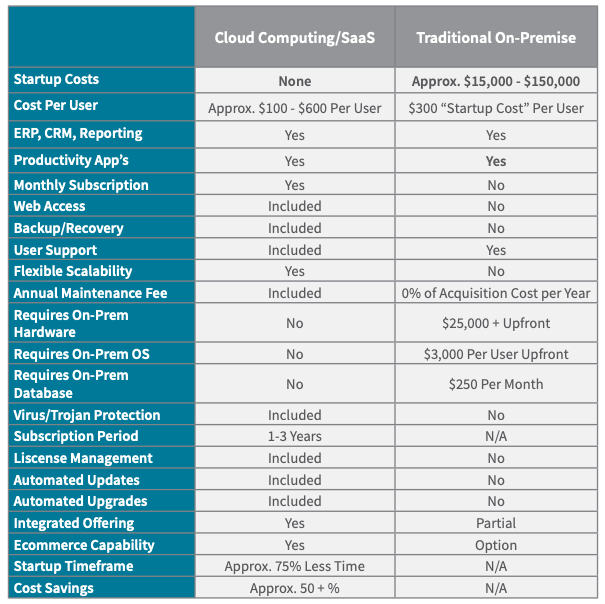Total Cost of Ownership

Getting the Lowest Total Cost of Ownership
When you consider the up-front cost to design and implement the financial accounting ERP system you need and the on-going expense of maintaining and upgrading it, plus the time and money to train and support your users, SMB Suite repeatedly proves our fixed-price cloud subscription model is the easiest and most affordable option on the market today. We know you want capabilities as well as the best value; so in what follows, we’ll walk you through the costs and pitfalls to consider when shopping for an integrated ERP business system . You’ll see that you can have the benefits of an ERP and CRM system built on the powerful Microsoft Dynamics GP platform accessible by browser anywhere in the world as well as running natively from within the Microsoft Office applications you use every day—all at a price point that no other provider can match.
In the end, if you still aren’t convinced, we’ve included a worksheet you can fill out while getting a quote from ERP provider you’re currently considering. Give us a call and we’ll walk through it with you step by step and give you a fair assessment of how our solution and pricing compare.
You just want to get the best possible value while meeting all of your organizational needs. If that’s not the case, and you’d like more information on how a cloud solution compares to on- premise then you’ll likely want to start with another e-book, “Why Integrated Cloud ERP is an Operational No-Brainer.” Or, if you’ve already got an on premise deployment of Microsoft Dynamics or another solution and you are considering the cost and benefits of upgrading that or migrating to a cloud environment you’ll want to read, “Upgrade or Cloud Migration?
Functionality and Finances.”
Otherwise, let’s continue by comparing the total cost of ownership between a cloud and an on premise solution. If you’re reading this then you are probably already convinced of the benefits of a cloudbased business solution: no hardware to buy and maintain, no licenses to purchase, vastly enhanced security and integrated data easily accessible by your team anytime, anywhere. But you’re worried about the cost so you’re considering all of your options including potentially on-premise.
The dwindling number of on-premise ERP providers are struggling not only because they fundamentally cannot offer the same features as cloud providers, but because their antiquated business model forces the end user to make significant, sometimes huge investments in up- front hardware, implementation and consulting costs. In exchange, they bear the burden of maintaining the hardware, supporting their users and paying significant sums in consulting hours whenever a customization or upgrade is required. So from day one, an on-premise solution can require a capital outlay of anywhere from $15,000- $150,000 or more. Our fixed-bid subscription pricing by contrast means you’ll have all of the customizations you want, unlimited support and the
resources of a state-of-the-art datacenter handling all of your critical operations for just the cost of your monthly user subscription. Based on years of selling and servicing on-premise
deployments before developing the most complete Microsoft Dynamics-based cloud solution we have found that most potential clients considering a first-time ERP deployment are wasting vital operating cash on equipment and consulting services they don’t need. Of course, every implementation is different.
But an on-premise solution will never offer the same value ; even with the most basic, non-customized, out-of-the-box deployment. This is because the intermittent months of lower maintenance payments are more than offset by the unmanageable up-front costs and the unmanageable costs to upgrade or expand your functionality as newer versions become available or your business needs grow. Even the most ideal implementation reflects a cost comparison that looks like this: (see graphic)
See? There’s a big spike up-front when you buy the platform. That’s money spent that could have been used to grow your business or invest in new opportunities. In year 2 and 3 your business is hopefully spending less on maintenance fees for the licenses you bought outright in year one. This is where an on-prem provider argues your business “makes it all back.” Of course that spike in the middle is the next time you need to upgrade to the latest version, incur more license expenses and endure potential consulting hours while the upgrade takes place. The bottom line is that an honest on-premise vendor can only guarantee that his solution might cost about the same as our cloud offering if, fingers-crossed, nothing ever goes wrong or needs updating.
And this idea reveals the final dealbreaker for any on-premise solution. Nothing ever goes perfectly in business.
Equipment breaks, passwords need resetting, updates need implementing, people need training, data needs backing up. If you’re on-prem you are almost certainly supporting most of this through your IT department. That’s a gigantic hidden cost many businesses ignore. But by forcing your IT department and your network to support your ERP system you force your strategic resources to spread themselves thin making sure everything is working and your corporate internet connection can support the traffic of daily operations plus dedicated ERP servers sucking up precious bandwidth. In fact, research into the ROI of onpremise computer deployments and cloud environments have revealed 2 stark facts: first, that the average business spends 3-5 times as much money supporting their onpremise environment over its useful lifespan than they spend in the initial investment. And, that every dollar invested in a cloud solution returned 50 cents in IT savings by freeing up those resources to focus on the issues more important to your business. So look at the general cost comparison chart above and imagine paying three times more than the price you see for on- premise while imagining half of the money spent on your cloud solution going right back into your business. The pricing contrast is obvious, isn’t it? That’s the economic realities of an on-premise solution compared to our cloud. Use the worksheet attached at the end of this document to get a full picture of what an on-prem solution is going to cost you and then give us a call. We’ll show you how to get more for less.
All Clouds Are Not The Same
If you’re on board with the value and functional benefits of a cloud ERP solution then you’re ready for the next step: evaluating multiple cloud solutions. The applications you rely on for your core business operations are an important investment, and it makes sense to shop for the best value. That’s why we love it when a customer comes to us last. Because we know at this point they feel like they’ve seen every pricing and service agreement gimmick under the sun and they’re ready to get some real, straight-forward answers. Here are the three big reasons why we can offer the lowest total cost of ownership compared to other cloud solutions:
1.) Technological Advantages The first 88 hours of any cloud implementation that we do are now automated by our proprietary technology. That means that not only are you not paying for those consulting hours, but you’re getting more than 2 weeks of your implementation taken care of in mere hours. That means a faster deployment time. We’ve also developed custom environments with the most relevant data metrics, dashboards and reports for specific industries like Wholesale & Distribution and Non-Profit Organizations. Again, the more we can rely on our technology the faster and cheaper our customers can go live.
2.) Fixed-Bid Subscription Pricing Many providers are happy to offer you a low monthly fee per user provided that you’re willing to use the one-size-fits-all environment they sell. If you need specific functionality or want a custom report designed for you then you’re paying for “time and materials”—a business model that means, “we’ll keep charging you by the hour no matter how long it takes us.” A business that finds itself over budget on an implementation and forced to keep the meter running while consultants sort-out the issues know how frustrating and powerless that feels. We rely on our proprietary technology to do the heavy lifting so it frees up our solution architects to work on the stuff that matters most to you—getting live fast with the functionality you need. Even better, we’ll give you a fixed price for any customizations or implementation requirements that you have. So the day you sign a service agreement with us you know you’ll never pay a penny more for unforeseen issues or customizations.
3.) Unlimited 24/7 Help Desk and On-going Training Included Our help desk goes way beyond just resetting passwords for your users. In addition to regular training to learn how to better use our solutions, we’re glad to walk any user through whatever process they’re trying to learn for the first time. Our help desk is not just for product support. It’s for user support. Other Cloud ERP providers charge an expensive monthly fee for often limited support.
Evaluating Your Own TCO: SMB Suite Cloud vs. On-Prem/SaaS
As you consider moving from your current, on-premises technology environment to Cloud Computing/SaaS, it is important that you evaluate your specific circumstances. Vendors everywhere are quick to give you their numbers, always leading to a positive outcome without knowing your specific business and budgetary requirements. To eliminate any bias, here’s a tool to help you evaluate your specific environment/ requirements and determine if you could benefit from Cloud Computing / SaaS. Get a pencil and take a look at the whole picture and then give us a call. We’ll walk through it together

Start Small Approach
Waited long enough for the right financial accounting software? Learn about our rapid deployment model.

Bundled Monthly Pricing
Gain complete visibility & control of your software investment, with easy-to-understand monthly payments.

Inclusiveness of Premier Services
Focus on running your business, not learning new software, with a team of dedicated experts.



